Reconfigurable Intelligent Surface Physical Model in Channel Modeling
Abstract
:1. Introduction
2. RIS Panel Physical Model
2.1. The Basic Considerations of the Assumption of the RIS Panel Physical Model
2.2. RIS Physical Model Abstraction
2.2.1. RIS element Pattern
- the physical structure of the RIS element.
- the single/dual polarization characteristics.
- the frequency dependence phase/interpolation loss.
- the incident direction and polarization direction of the incident EM wave.
2.2.2. RIS Panel Radiation Direction Map
3. Simulation Verification
4. Results
Author Contributions
Funding
Conflicts of Interest
Nomenclature
| the unit vector in the vertical plane of incidence | |
| the component perpendicular to the plane of incidence and | |
| the direction of electromagnetic wave incidence | |
| the normal vector of the RIS panel | |
| the direction of electromagnetic wave reflection | |
| the incident electric field | |
| the electric field of horizontally polarized waves | |
| the electric field of vertically polarized waves | |
| the dyadic reflection coefficient | |
| the reflected electric field | |
| the incident magnetic field | |
| the reflected magnetic field | |
| the total electric field | |
| the total magnetic field | |
| the scattered electric fields in the far zone | |
| the scattered magnetic fields in the far zone | |
| the angular frequencies | |
| the free-space permittivity | |
| the free-space permeability | |
| the three-dimensional spatial Green’s functions | |
| the scattering direction unit vector | |
| the scattered electric fields excited by the RIS element | |
| the scattered magnetic fields excited by the RIS element | |
| the free-space wave impedance | |
| the coordinates of the surface element points in the RIS element | |
| the coordinates of the far-field observation points | |
| the electric field excited by the RIS element in the first polarization direction | |
| the magnetic field excited by the RIS element in the first polarization direction | |
| the electric field excited by the RIS element in the second polarization direction | |
| the magnetic field excited by the RIS element in the second polarization direction | |
| the controlled bias | |
| the total effective feed-in power of the RIS panel | |
| the RIS panel-reflected power coefficient | |
| the RIS panel area | |
| the incident wave front power | |
| the angle between the incident wave vector and the RIS panel normal | |
| the average effective feed-in power of each RIS unit | |
| the number of RIS elements | |
| the electric field in the first polarization direction | |
| the magnetic field in the first polarization direction | |
| the electric field in the second polarization direction | |
| the magnetic field in the second polarization direction | |
| the total scattered electric field at the target field point | |
| the total scattered magnetic electric field at the target field point |
References
- Dou, J.W.; Chen, Y.J.; Zhang, N.; Fang, M.; Peng, L. On the channel modeling of intelligent controllable electromagnetic-surface. Chin. J. Radio Sci. 2021, 36, 368–377. (In Chinese) [Google Scholar]
- Degli-Esposti, V.; Vitucci, E.M.; Di Renzo, M.; Tretyakov, S. Reradiation and scattering from a reconfigurable intelligent surface: A general macroscopic model. IEEE Trans. Antennas Propag. 2022, 1. [Google Scholar] [CrossRef]
- Di Renzo, M.; Danufane, F.H.; Tretyakov, S. Communication models for reconfigurable intelligent surfaces: From surface electromagnetics to wireless networks optimization. arXiv 2021, arXiv:2110.00833. [Google Scholar]
- Danufane, F.H.; Di Renzo, M.; De Rosny, J.; Tretyakov, S. On the path-loss of reconfigurable intelligent surfaces: An approach based on Green’s theorem applied to vector fields. IEEE Trans. Commun. 2021, 69, 5573–5592. [Google Scholar] [CrossRef]
- Di Renzo, M.; Danufane, F.H.; Xi, X.; De Rosny, J.; Tretyakov, S. Analytical modeling of the path-loss for reconfigurable intelligent surfaces–anomalous mirror or scatterer? In Proceedings of the 2020 IEEE 21st International Workshop on Signal Processing Advances in Wireless Communications (SPAWC), Atlanta, GA, USA, 26–29 May 2020; pp. 1–5. [Google Scholar]
- Balanis, C.A. Antenna Theory: Analysis and Design; John Wiley & Sons: Hoboken, NJ, USA, 2015. [Google Scholar]
- Ellingson, S.W. Path loss in reconfigurable intelligent surface-enabled channels. In Proceedings of the 2021 IEEE 32nd Annual International Symposium on Personal, Indoor and Mobile Radio Communications (PIMRC), Helsinki, Finland, 13–16 September 2021; pp. 829–835. [Google Scholar]
- Özdogan, Ö.; Björnson, E.; Larsson, E.G. Intelligent reflecting surfaces: Physics, propagation, and pathloss modeling. IEEE Wirel. Commun. Lett. 2019, 9, 581–585. [Google Scholar] [CrossRef]
- Díaz-Rubio, A.; Tretyakov, S.A. Macroscopic modeling of anomalously reflecting metasurfaces: Angular response and far-field scattering. IEEE Trans. Antennas Propag. 2021, 69, 6560–6571. [Google Scholar] [CrossRef]
- Tang, W.; Chen, M.Z.; Chen, X.; Dai, J.Y.; Han, Y.; Di Renzo, M.; Zeng, Y.; Jin, S.; Cheng, Q.; Cui, T.J. Wireless communications with reconfigurable intelligent surface: Path loss modeling and experimental measurement. IEEE Trans. Wirel. Commun. 2020, 20, 421–439. [Google Scholar] [CrossRef]
- Tang, W.; Chen, X.; Chen, M.Z.; Dai, J.Y.; Han, Y.; Di Renzo, M.; Jin, S.; Cheng, Q.; Cui, T.J. Path loss modeling and measurements for reconfigurable intelligent surfaces in the millimeter-wave frequency band. arXiv 2021, arXiv:2101.08607. [Google Scholar]
- Najafi, M.; Jamali, V.; Schober, R.; Poor, H.V. Physics-based modeling and scalable optimization of large intelligent reflecting surfaces. IEEE Trans. Commun. 2020, 69, 2673–2691. [Google Scholar] [CrossRef]
- Suter, E.; Mosig, J.R. A subdomain multilevel approach for the efficient MoM analysis of large planar antennas. Microw. Opt. Technol. Lett. 2000, 26, 270–277. [Google Scholar] [CrossRef]
- Ling, F.; Jin, J.M. Hybridization of Sbr and Mom for Scattering By Large Bodies With Inhomogeneous Protrusions—Summary. J. Electromagn. Waves Appl. 1997, 11, 1249–1255. [Google Scholar] [CrossRef]
- Ling, H.; Chou, R.C.; Lee, S.W. Shooting and bouncing rays: Calculating the RCS of an arbitrarily shaped cavity. IEEE Trans. Antennas Propag. 1989, 37, 194–205. [Google Scholar] [CrossRef]
- Jin, J.M.; Ni, S.S.; Lee, S.W. Hybridization of SBR and FEM for scattering by large bodies with cracks and cavities. IEEE Trans. Antennas Propag. 1995, 43, 1130–1139. [Google Scholar]
- Bhalla, R.; Ling, H. A fast algorithm for signature prediction and image formation using the shooting and bouncing ray technique. IEEE Trans. Antennas Propag. 1995, 43, 727–731. [Google Scholar] [CrossRef]
- Katz, M. Introduction to Geometrical Optics; World Scientific: Singapore, 2002. [Google Scholar]
- Wood, R.W. Physical Optics; Macmillan: New York, NY, USA, 1905. [Google Scholar]
- Stratton, J.A.; Chu, L.J. Diffraction theory of electromagnetic waves. Phys. Rev. 1939, 56, 99. [Google Scholar] [CrossRef]
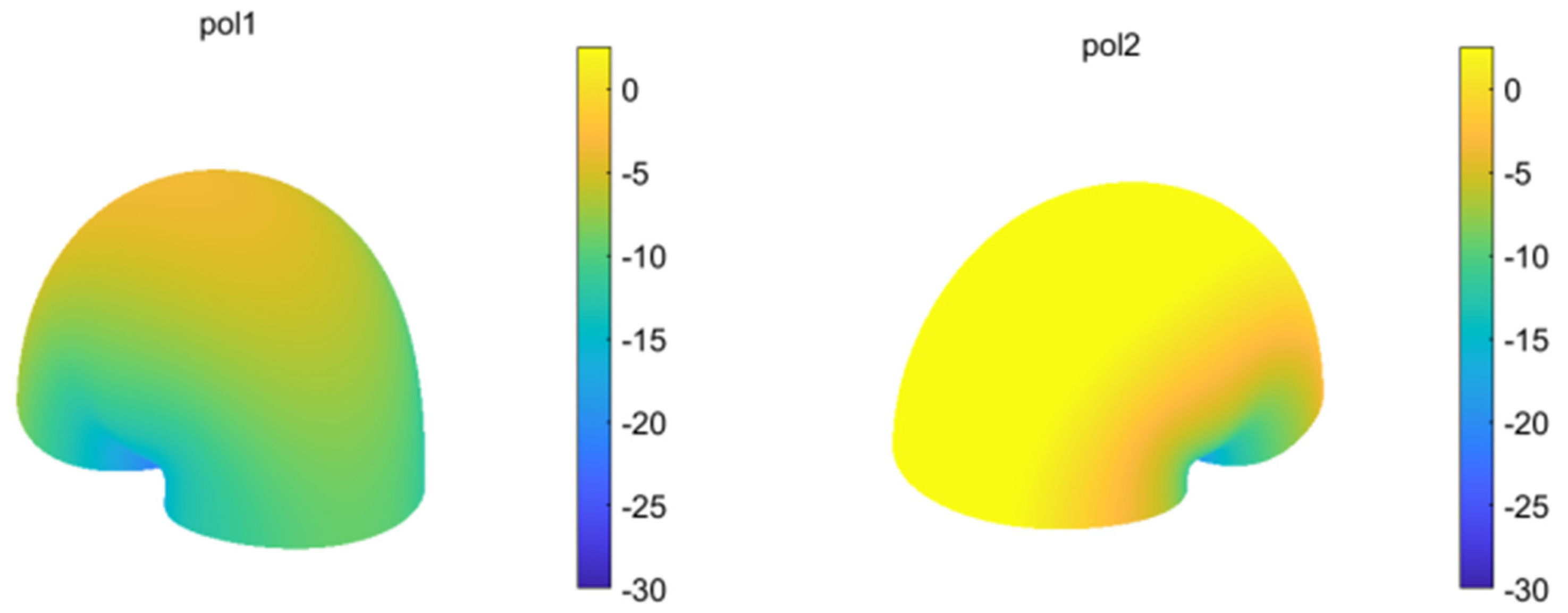
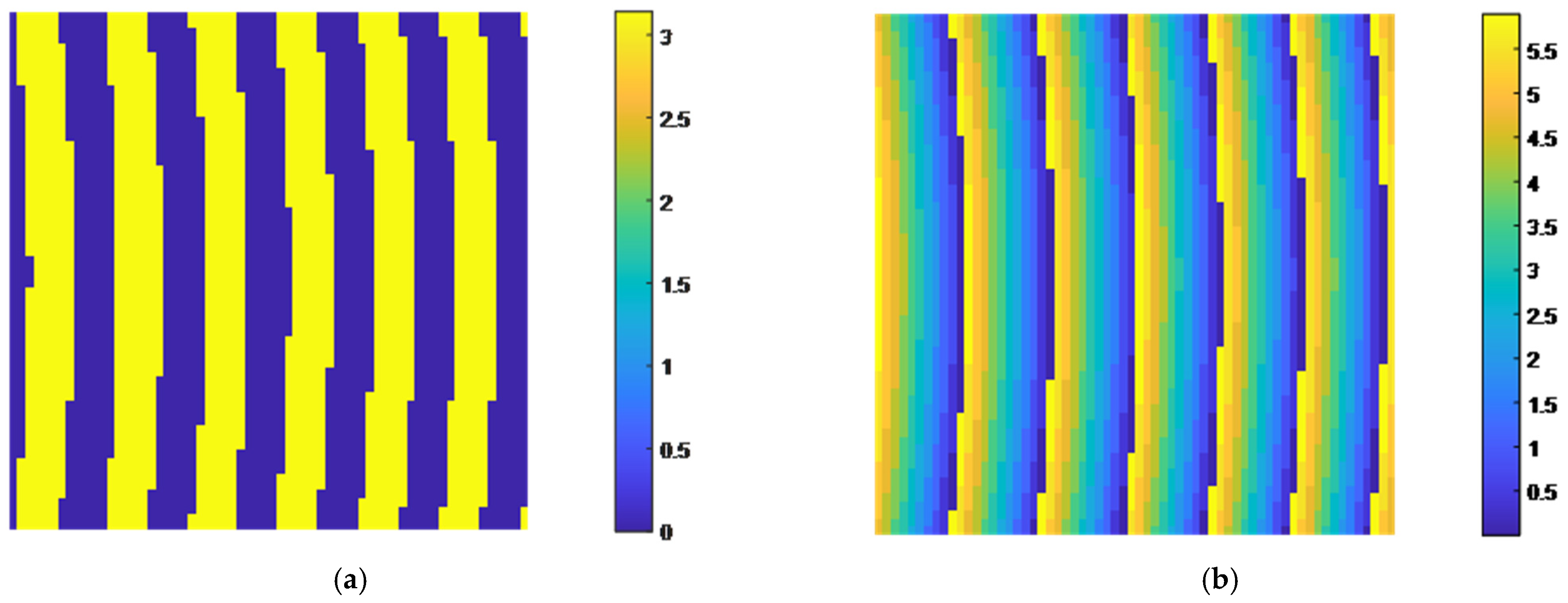
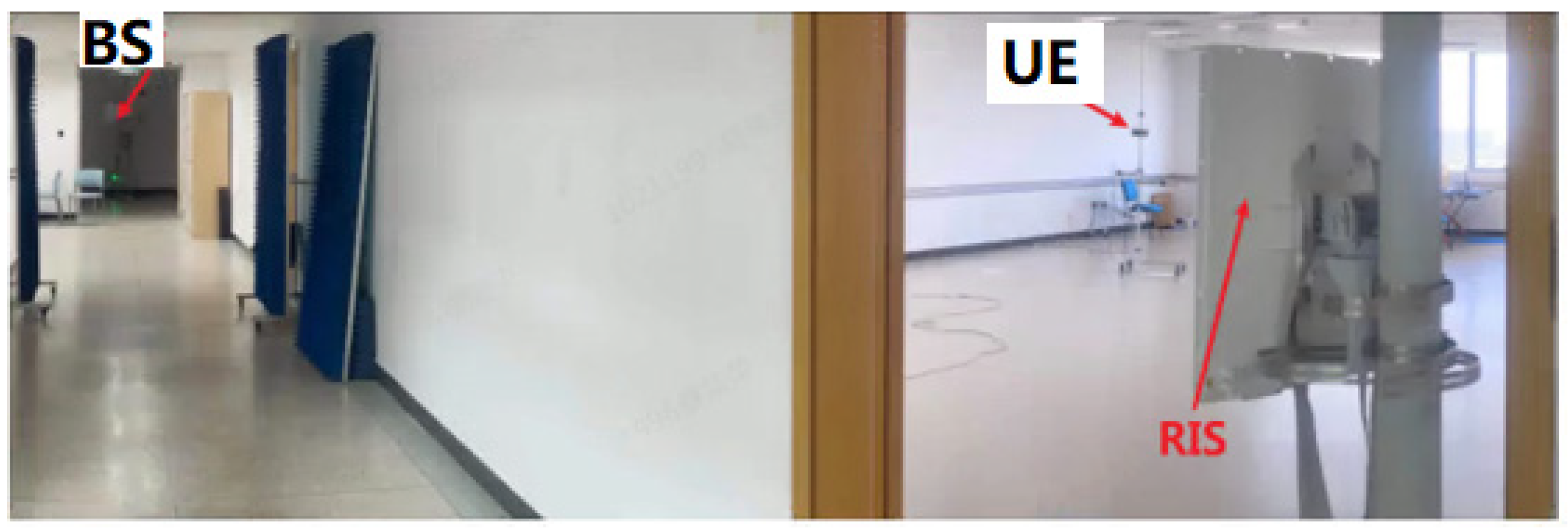
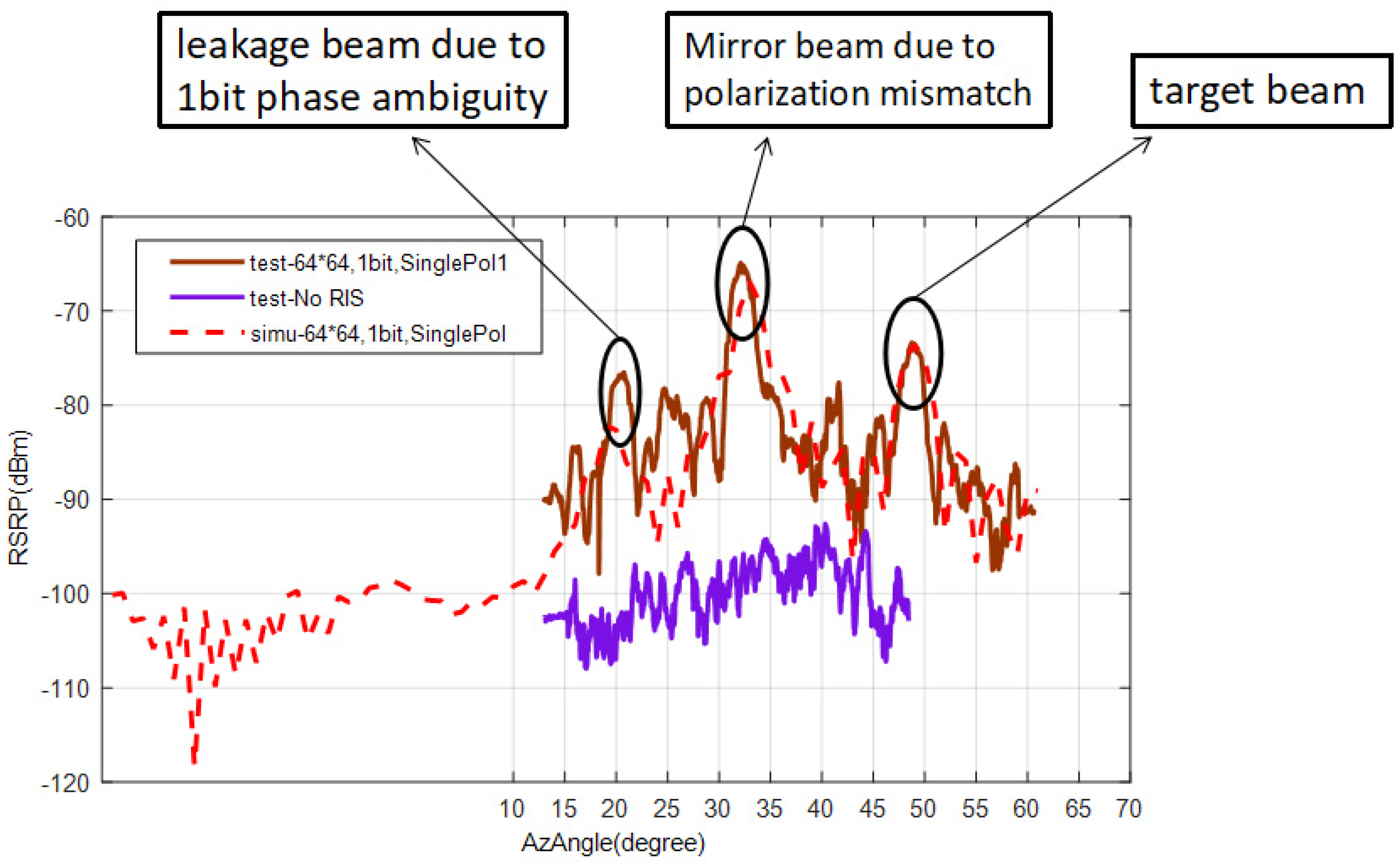
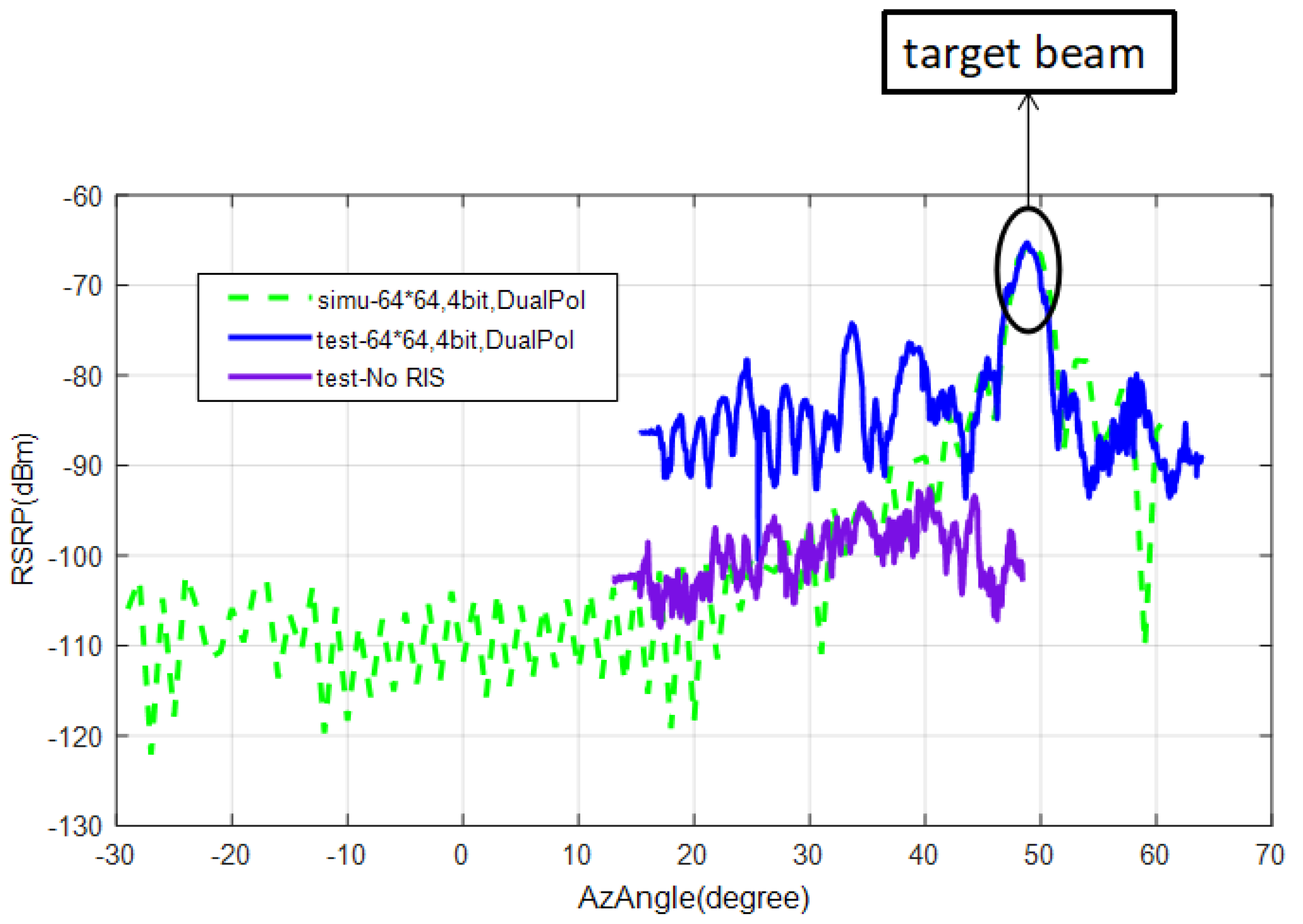
| Parameters | Value | Unit |
|---|---|---|
| Base station location | [19.99, 0.69, 1]T | m |
| RIS location | [0, 0, 1]T | m |
| Receiving point location | [2.08, −9.78, 1]T | m |
| RIS azimuth angle | −30 | degree |
| RIS elevation angle | 0 | degree |
| RIS slant angle | 0 | degree |
| Polarization of 1-bit RIS panel | Single polarization with −45-degree rotation with respect to horizontal edge of RIS panel | degree |
| Polarization of 4-bit RIS panel | Dual polarization with ±45-degree rotation with respect to horizontal edge of RIS panel | degree |
| Incident wave vector polarization angle | −23 | degree |
| RIS orthogonal polarization phase bias | 0 | degree |
| Carrier frequency | 26.9 | GHz |
| Number of RIS elements (Nx × Ny) | 64 × 64 | - |
| RIS horizontal array spacing | 0.45 | |
| RIS vertical array spacing | 0.45 |
Publisher’s Note: MDPI stays neutral with regard to jurisdictional claims in published maps and institutional affiliations. |
© 2022 by the authors. Licensee MDPI, Basel, Switzerland. This article is an open access article distributed under the terms and conditions of the Creative Commons Attribution (CC BY) license (https://creativecommons.org/licenses/by/4.0/).
Share and Cite
Liu, Y.; Dou, J.; Cui, Y.; Chen, Y.; Yang, J.; Qin, F.; Wang, Y. Reconfigurable Intelligent Surface Physical Model in Channel Modeling. Electronics 2022, 11, 2798. https://doi.org/10.3390/electronics11172798
Liu Y, Dou J, Cui Y, Chen Y, Yang J, Qin F, Wang Y. Reconfigurable Intelligent Surface Physical Model in Channel Modeling. Electronics. 2022; 11(17):2798. https://doi.org/10.3390/electronics11172798
Chicago/Turabian StyleLiu, Yiping, Jianwu Dou, Yijun Cui, Yijian Chen, Jun Yang, Fan Qin, and Yuxin Wang. 2022. "Reconfigurable Intelligent Surface Physical Model in Channel Modeling" Electronics 11, no. 17: 2798. https://doi.org/10.3390/electronics11172798
APA StyleLiu, Y., Dou, J., Cui, Y., Chen, Y., Yang, J., Qin, F., & Wang, Y. (2022). Reconfigurable Intelligent Surface Physical Model in Channel Modeling. Electronics, 11(17), 2798. https://doi.org/10.3390/electronics11172798






